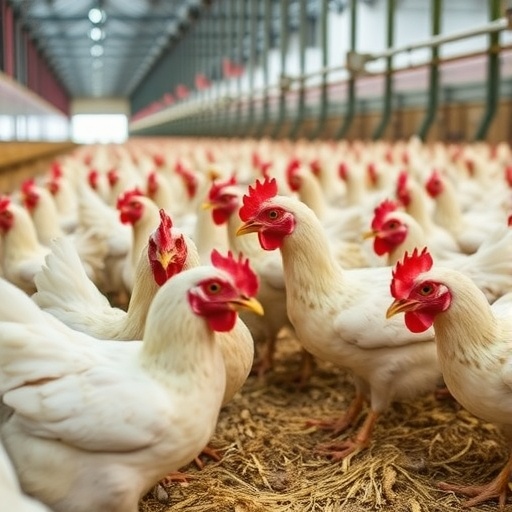In the dynamic world of poultry production, the significance of microbial diversity in hatcheries has emerged as a pivotal topic, particularly concerning the economic ramifications it entails for the poultry industry. A recent study titled “Evaluation of microbial diversity, economic implication and level of awareness of possible causes of runting leading to hatchery condemnation in a commercial poultry hatchery hub” sheds light on these critical aspects. The research conducted by Adebiyi, Adeyemo, and Batubo not only emphasizes the biological complexities of hatcheries but also elucidates the pressing need for awareness among poultry producers regarding the underlying causes of runting—a condition that can lead to substantial losses through hatchery condemnations.
The implications of runting in hatcheries extend far beyond the immediate health concerns for the birds. From an economic standpoint, runting can lead to increased mortality rates, reduced hatchability, and the subsequent condemnation of affected batches. Such losses not only affect the bottom line of hatchery operators but also strain the supply chain of poultry products. Consumers ultimately bear the costs of these inefficiencies through price increases and reduced availability of poultry goods.
.adsslot_SYGPKjgfz4{ width:728px !important; height:90px !important; }
@media (max-width:1199px) { .adsslot_SYGPKjgfz4{ width:468px !important; height:60px !important; } }
@media (max-width:767px) { .adsslot_SYGPKjgfz4{ width:320px !important; height:50px !important; } }
ADVERTISEMENT
Additionally, the awareness level among hatchery managers regarding the potential causes of runting is alarmingly low, as underscored by the study’s findings. This gap in knowledge underscores a critical need for educational initiatives aimed at improving understanding of microbial interactions, hatchery management practices, and biosecurity measures. Implementing targeted training can empower hatchery personnel and producers to adopt practices that would mitigate the risks associated with microbial imbalances, thereby fostering a more resilient poultry industry.
Integral to the study is an evaluation of the economic implications associated with hatchery condemnations due to runting. Financial impacts manifest in numerous ways, including the cost of lost production, expenditures on corrective measures, and potential reputational harm in the industry. By quantifying these aspects, the researchers provide valuable insights that can guide hatchery operators towards making informed business decisions while safeguarding their operations against the disruptions caused by microbial issues.
Moreover, the study delineates the role of biosecurity in combating runting and enhancing overall hatchery health. Biosecurity measures, designed to minimize the incidence of infections and microbial contamination, are pivotal in ensuring the integrity of the poultry ecosystem. Awareness of compliance with these protocols can serve as the frontline defense against health threats in commercial hatcheries, supporting the notion that prevention is preferable to remediation.
As hatchery operators grapple with the challenge of balancing productivity and biosecurity, the study underscores the necessity of continuous monitoring and research to ascertain the specific microbial communities present within their environments. High-throughput sequencing techniques and advanced microbial analysis tools can identify both beneficial and pathogenic microorganisms, forming the basis for more tailored interventions aimed at improving hatchery outcomes.
Additionally, the social dimension of the issue cannot be overlooked. The researchers argue for a collective approach to elevating awareness and education within the industry. Cooperative efforts between hatcheries, veterinary scientists, and poultry health professionals can result in the development of comprehensive guidelines and best practice frameworks that can be employed universally. Through collaboration, the industry can foster a culture of continuous improvement and shared responsibility for the health and prosperity of poultry production.
Furthermore, the political and regulatory landscape surrounding animal agriculture is shifting towards more stringent standards for animal health and welfare. Studies like this one underscore the growing urgency for hatchery operators to adhere to best practices underscored by scientific research. Regulatory bodies may increasingly call for transparency regarding microbial management practices within hatcheries, compelling operators to invest in upgrading facilities and adopting new technologies that ensure compliance.
Through understanding and action, the findings of this research possess the power to revolutionize how hatcheries manage microbial diversity and respond to the multifaceted challenges they face, ultimately driving a healthier future for poultry production.
Subject of Research: Microbial diversity and its impact on poultry hatcheries.
Article Title: Evaluation of microbial diversity, economic implication and level of awareness of possible causes of runting leading to hatchery condemnation in a commercial poultry hatchery hub.
Article References:
Adebiyi, A.I., Adeyemo, I., Batubo, A.P. et al. Evaluation of microbial diversity, economic implication and level of awareness of possible causes of runting leading to hatchery condemnation in a commercial poultry hatchery hub.
Discov Anim 2, 22 (2025). https://doi.org/10.1007/s44338-025-00057-y
Image Credits: AI Generated
DOI: 10.1007/s44338-025-00057-y
Keywords: Microbial diversity, poultry hatcheries, runting, economic implications, biosecurity, poultry health.
Tags: avian health during developmentawareness of poultry health issuesbeneficial microorganisms in hatcheriescauses of runting in poultrycomplexities of poultry productiondetrimental effects of microbial overgrowtheconomic impact of hatchery condemnationshatchery management practicesimproving hatchery outcomes through awarenessmicrobial diversity in poultry hatcheriesmicrobial ecosystems in poultrypoultry industry economic challenges





